Show / Hide Article Options
Saturday 22nd of January 2022
Monday 4th of November 2019
Thursday 25th of April 2019
Friday 14th of September 2018
Monday 21st of May 2018
Wednesday 20th of September 2017
place - infront of any word to exclude
articles containing that word.
Example: website -wordpress
Created / Updated on Saturday 22nd of January 2022
Summaries of the findings of these five scientific research projects are given below. Details for obtaining the full papers are also given. A huge amount of time and effort has been provided on a voluntary basis to carry out and complete these scientific studies. All those who assisted, including staff at the Ecosciences Precinct, University of Queensland, Fisheries Queensland and NSW Fisheries, are sincerely thanked.
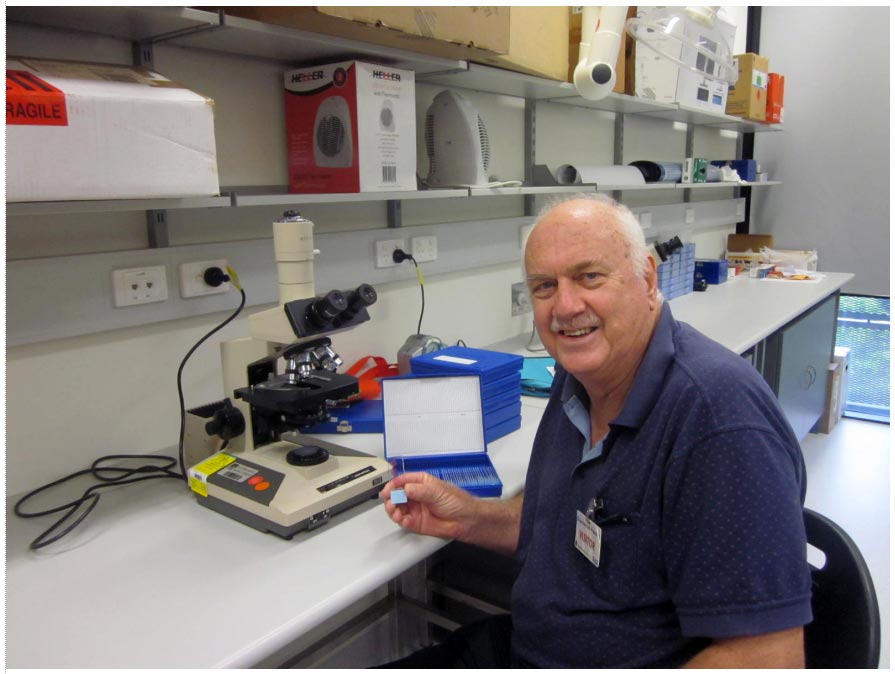
Dr Barry Pollock, Scientific Officer Sunfish, at the Ecosciences Precinct Boggo Road, using a microscope to examine flathead reproductive tissue samples.
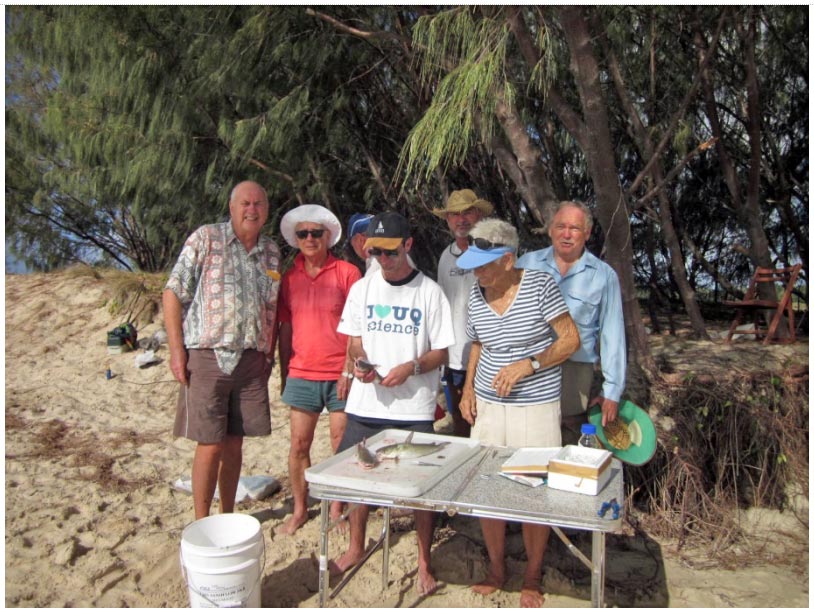
Sunfish affiliated recreational fishers assisting a University of Queensland research project.
1. Saddleback in bream caused by a physical injury.

Original Article
Saddleback syndrome in yellowfin bream [Acanthopagrus australis (Günther, 1859)] in Moreton Bay, Australia: its form, occurrence, association with other abnormalities and cause†
B.R. PollockFirst published: 24 April 2015
Summary
The aim of this study was to determine if saddleback syndrome (SBS) in a wild population of yellowfin bream (Acanthopagrus australis) was the result of a developmental defect or caused by physical injury. Information was collected in 2012 on the incidence of SBS and other abnormalities in this species in Moreton Bay, Australia. Abnormalities in adult fish (>250 mm Total Length, TL) with SBS (n = 47) were compared with those without SBS (n = 30). A sample of juvenile fish (n = 404) was checked for the presence of SBS. The results show that scale loss, scale pattern misalignment, lateral line fracture and pectoral fin abnormality were closely associated with SBS. SBS was uncommon (<2%) in juveniles >70 mm TL, but common (>12%) in the larger juveniles (70 - 215 mm TL). These results, together with the findings that scale loss associated with SBS in adult fish occurred in the range 80 - 245 mm back‐calculated TL, indicate that SBS and the related abnormalities in yellowfin bream are a result of physical injuries to larger juveniles (>70 mm TL). The reduction in the incidence of SBS from approximately 12% in the larger juveniles to 5% in adults is evidence of mortality associated with SBS.
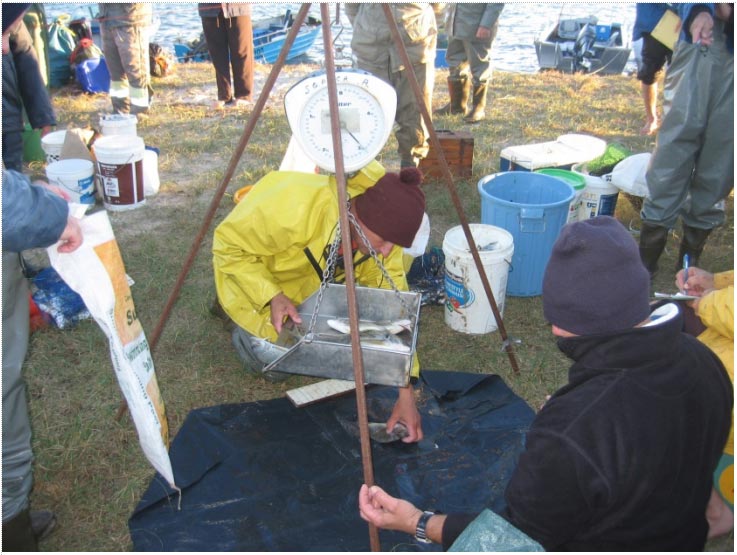
Specimens of bream supplied by QAFCA and SQAFCA recreational fishers.
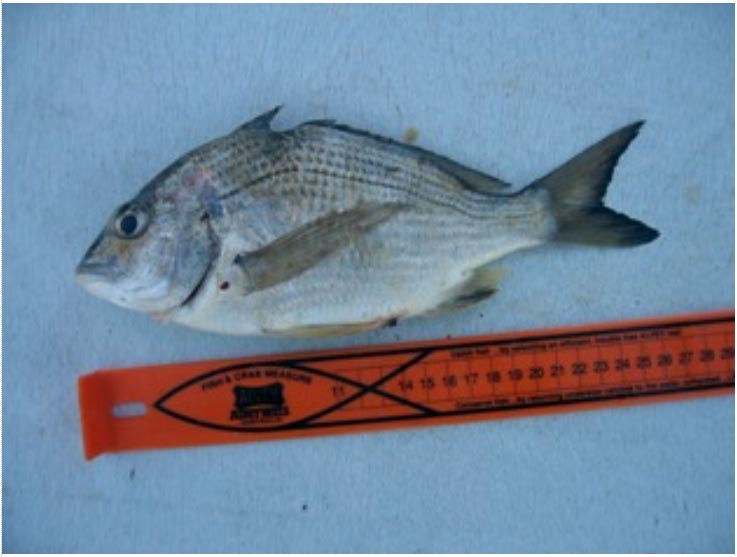
A typical bream with saddleback. – caught by a recreational fisher in SE Queensland.
Copy of the full paper is on the Sunfish website: Editorials – Projects – Bream Project.
2. Large female dusky flathead >70cm make a minor contribution to egg production.
Proceedings of the Royal Society of Queensland 2014, volume 119, pages 21-34.THE ANNUAL SPAWNING AGGREGATION OF DUSKY FLATHEAD PLATYCEPHALUS FUSCUS AT JUMPINPIN, QUEENSLAND POLLOCK, B.R.
ABSTRACT
Dusky flathead Platycephalus fuscus form seasonal spawning aggregations where estuaries meet the ocean in eastern Australia. The present study at Jumpinpin in south Queensland shows that dusky flathead have a protracted spawning period with serial spawning during summer (November to April). They are rudimentary hermaphrodites with sex determined at an early juvenile stage. Sex ratios are skewed with males most common in the smaller size-classes (< 50 cm TL). Mid-sized females (45cm - 69 cm TL) dominate the production of eggs due to their abundance in the spawning aggregation. Within the female component of the spawning aggregation, the occurrence of individuals exceeding the current maximum size limit of 75 cm TL is low (2.6%). Parasitic nematodes (philometrids) occurred in 8% of ovaries. Degenerated ovaries, in which atretic oocytes are common, are present in half of the very large females (70 cm - 75cm TL) examined. The current minimum size restriction of 40 cm TL for dusky flathead provides protection for 73% of males and 15% of females within the spawning aggregation.
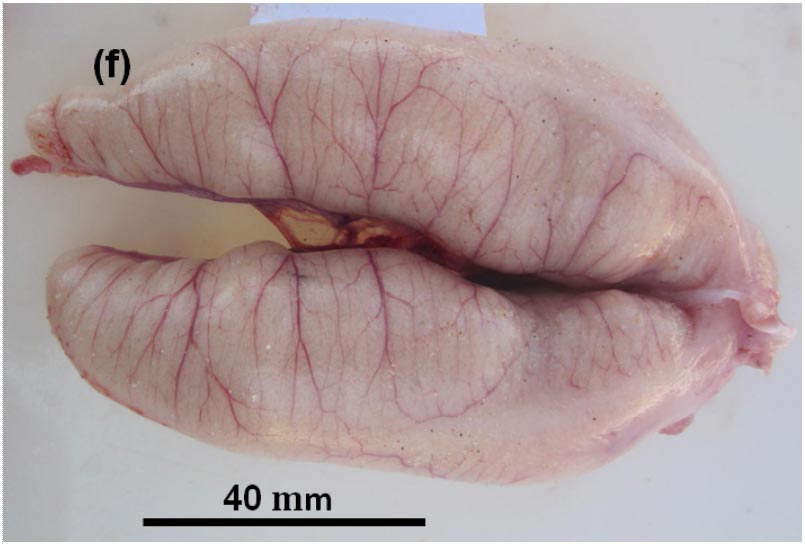
Above: Degenerate (mushy) ovary from a large female dusky flathead.
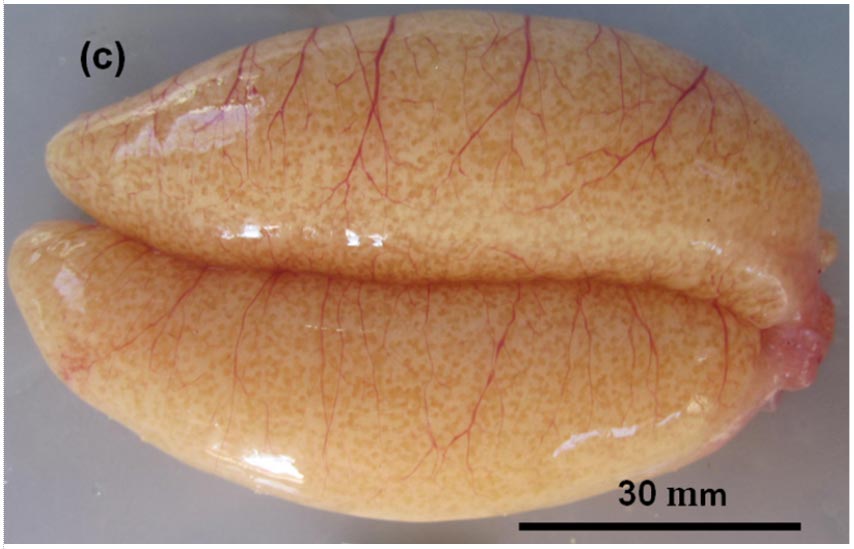
Above: Running ripe ovary from a mid-size dusky flathead.
A copy of the full paper is on the Sunfish website: Editorials – Projects – Dusky Flathead Project.
3. Reduced population of Luderick in SE Queensland – resulting from increase in coastal water temperature.


RESEARCH ARTICLE


Latitudinal change in the distribution of luderick Girella tricuspidata (Pisces: Girellidae) associated with increasing coastal water temperature in eastern Australia
B. R. Pollock
Marine and Freshwater Research 68(6) 1187-1192 https://doi.org/10.1071/MF16070
Submitted: 19 January 2016 Accepted: 5 July 2016 Published: 17 August 2016
Abstract
During the past two decades there has been a major decline in the luderick (Girella tricuspidata) population and fishery in the coastal areas of southern Queensland, Australia. This region is the northern limit of the range of luderick. An analysis of annual time series information from the luderick fishery and from sea surface temperature records from 1976 to 2015 found a moderate and significant negative correlation (Pearson r = –0.39, P < 0.05) between water temperature and population abundance in southern Queensland. Previous studies of juvenile and adult luderick indicate their sensitivity to elevated water temperature at the northern limit of their range, further supporting the hypothesis that declines in population abundance of luderick in southern Queensland are associated with increased water temperature. Other possible factors for the luderick population decline (overfishing and habitat loss) are discussed. Any future increases in coastal water temperatures in eastern Australia may result in further southward shifts of the luderick population, and may have similar effects on other fish species that have their northern range limits in southern Queensland.
A full copy of this paper may be purchased from the publisher. Go to: https://www.publish.csiro.au/cart
4. Reproduction of female dusky flathead in the Clarence River, NSW.
Research Article
B. R. Pollock*
Sunfish Queensland, Brisbane, Australia
Received: July 02, 2019; Published: July 15, 2019
ABSTRACT
The aim of the present study is to examine developmental changes of oocytes and ovaries of a wild population of dusky flathead Platycephalus fuscus (Cuvier, 1829). This fish is endemic to the east coast of Australia where it inhabits estuaries and coastal waters. It is extensively fished throughout its range. It is a serial spawning teleost, capable of producing vast numbers of externally fertilised eggs in batches over a protracted annual spawning period. Successful egg production, as indicated by the presence of hydrated oocytes and post ovulatory follicles, is commonly observed in small and mid-size females (35 cm – 65cm Total Length; 2 – 6 years old) which numerically dominate the female component of the spawning aggregation. Oocyte atresia, at various levels, commences at the vitellogenic oocyte stage, and occurs in all mature fish during the spawning period. Mass oocyte atresia and degenerate ovaries were commonly observed in large fish (>70 cm Total Length and 7 years old), indicating that reproductive senescence occurs after females reach this size.
This paper is available, free of charge, at: https://escientificpublishers.com/oogenesis-oocyte-atresia-ovarian-development-and-reproductive-senescence-in-the-dusky-flathead-platycephalus-fuscus-teleostei-AVAS-01-0004
Brief Summary - Dusky Flathead female reproductive biology
1. Dusky flathead do not change sex from male to female. Sex is determined at the juvenile stage and individuals maintain that sex. However there is a marked sexual dimorphism with females growing to a much larger size than males.
2. Mature females range in size from approximately 35cm to 100cm Total Length. However the mid-size females numerically dominate this component of the dusky flathead population. For example in the Jumpinpin study fish over 75cm made up 2.6% of the female spawning aggregation, and Gray and Barnes in the NSW study report an even smaller proportion of females fish over 70cm. Due to their relative abundance, the mid-size females dominate egg production - the large females >70cm, although potentially capable of producing large amounts of eggs by individuals, make a very minor contribution to egg production by the total female spawning population.
3. The Sunfish studies of spawning aggregations at Jumpinpin and Clarence River found mass atresia commencing in females over 70cm, indicating reproductive senescence. Therefore to combined effects of low relative abundance and reproductive senescence results in very low levels of egg production by large females >70cm.
4. How important are "super spawner" dusky flathead? The recent debate in the journal Science covered the super spawner topic. A very highly regarded stock assessment scientist made the comment: Ray Hilborn, a fisheries biologist at the University of Washington in Seattle, argues that because superspawners are relatively rare, even in unfished populations, their overall contribution to the population is not particularly great. Accounting for superspawners would make little difference to how you manage a fishery. This view is supported in the case of large female dusky flathead, based on the recent scientific research.
5. Causation of Saddleback Deformities in the Yellowfin Bream Acanthopagrus australis Fishery:
Evidence of Physical Injury.B. R. Pollock, Sunfish
Asian Journal of Fisheries and Aquatic Research (published January 2022)
ABSTRACT
The yellowfin bream A. australis supports an important commercial net and angling fishery on the east coast of Australia. Saddleback, a deformity of the dorsal fin and profile, occurs in this species, with the occurrence of fish with saddleback being as high as 10% in some areas. The present study provides new information and analysis of causation of the saddleback deformity in the yellowfin bream fishery. Lateral line scale regeneration due to injury, and soft tissue abnormalities indicative of deep wounding are present in yellowfin bream with saddleback. X-ray images of the entire skeleton of specimens with saddleback were also examined. An unpublished government report on chemical residues in saddleback and normal yellowfin bream is appended and discussed. The absence of both chemical residues, and lack of other skeletal deformities in yellowfin bream with saddleback provide indirect evidence of physical injury as the cause of saddleback in this case. The role of discarding of meshed yellowfin bream, which are smaller than the legal minimum size, as causation of the saddleback deformity is evaluated.
This paper is available, free of charge, at: Causation of Saddleback Deformities in The Yellowfin Bream Acanthopagrus australis Fishery: Evidence of Physical Injury | Asian Journal of Fisheries and Aquatic Research
Queensland snapper book published by Sunfish
The Queensland Snapper (Chrysophrys auratus) Fishery. History, Stock Assessments and Management.
Barry Pollock
A Sunfish open access publication

Filesize : 6,626 KB
Date : 30 Aug 2022 10:51

